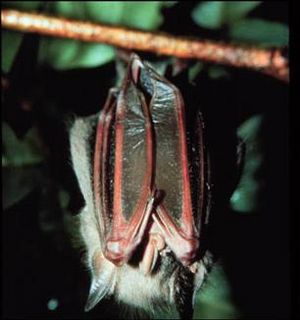Red fruit bat facts for kids
Quick facts for kids Red fruit bat |
|
|---|---|
 |
|
| Conservation status | |
| Scientific classification | |
| Genus: |
Stenoderma
|
| Species: |
rufum
|
The red fruit bat or red fig-eating bat (Stenoderma rufum) is a special kind of bat. It belongs to the Phyllostomidae family, which are often called leaf-nosed bats. This bat is the only species in its group, called a monotypic genus Stenoderma.
You can find red fruit bats living in Puerto Rico and the U.S. Virgin Islands.
Contents
About the Red Fruit Bat
Red fruit bats can be different shades of brown, from light tan to dark brown. Their wings are usually dark brown or black. Interestingly, their arms and fingers are often red or pink!
They have a unique nose-leaf, which is a fleshy growth on their nose. It stands up straight and looks a bit like a leaf. Their ears are pointed and change color from light brown at the bottom to dark brown at the top. They have small, oval-shaped eyes with dark brown centers.
Young bats have lighter fur. As they grow up, they shed this fur and get their darker adult fur. Bats from Puerto Rico tend to be a darker brown than those found on St. John. Both young and adult bats have darker fur on their bellies than on their backs. They also have two white spots: one on each side of their neck near their ears, and another at their wing joints.
Size Differences
Female red fruit bats from Puerto Rico are usually bigger than the males. This difference in size between males and females is called sexual dimorphism. However, this size difference is not seen in the bats living on St. John.
On average, female bats from Puerto Rico are about 6.8 centimeters (2.7 inches) long. Their forearm, which is a key measurement for bats, is about 5 centimeters (2 inches) long. Their skull is around 2.3 centimeters (0.9 inches) long.
Female bats from St. John are a bit smaller. They are about 6.5 centimeters (2.6 inches) long. Their forearm is around 4.7 centimeters (1.9 inches), and their skull is about 2.2 centimeters (0.87 inches) long.
Male bats from both places are generally the same size. They are about 6.1 to 6.6 centimeters (2.4 to 2.6 inches) long. Their forearm is around 4.7 to 4.8 centimeters (1.85 to 1.89 inches), and their skull is about 2.2 centimeters (0.87 inches) long.
Types of Red Fruit Bats
Scientists recognize three different types, or subspecies, of the red fruit bat:
- Stenoderma rufum rufum (Desmarest's red fruit bat) - Found in the U.S. Virgin Islands.
- †Stenoderma rufum anthonyi (Anthony's red fruit bat) - This type only exists as fossils and was found in Puerto Rico. The dagger (†) means it's extinct.
- Stenoderma rufum darioi (Valdivieso's red fruit bat) - Found in Puerto Rico.
Where Red Fruit Bats Live and What They Eat
Range and Habitat
Red fruit bats naturally live in dry forests in warm, tropical places. You can find them on the islands of Puerto Rico, St. John, and St. Thomas in the U.S. Virgin Islands.
In 2004, a pregnant female bat was found on the island of St. Croix. This showed that red fruit bats are also living and having babies there! Most red fruit bats are found in the Luquillo National Forest in Puerto Rico. This is a mountain area that gets a lot of rain every year.
Diet
Red fruit bats are frugivores, which means they mostly eat fruit. They especially like fruits from trees like Cecropia schrebriana, Manilkara bidentata, and Prestoea montana.
They can also eat mangos, fruit nectar, and bananas. However, they need the fruit's soft inside to be open or exposed for them to eat it easily.
Behavior
Red fruit bats are nocturnal, meaning they are active at night. Many nocturnal animals become less active when the moon is bright. This is because predators can see them more easily in brighter moonlight.
However, red fruit bats in Puerto Rico don't have many predators that hunt at night. This means they can search for food or mates no matter how bright the moon is.
Reproduction and Life Cycle
Scientists don't know a lot about how red fruit bats mate and have babies. What they do know is that male bats tend to mate more during the dry seasons. Female bats, however, can mate all year round. This means females can have babies multiple times a year.
The size of the baby bats (embryos) inside the mother can also depend on the season. Smaller embryos are more common during the dry seasons than during the rainy seasons.
When baby bats are born, they are already covered in fur. Their faces are pink and hairless, and their eyes are open. At birth, they are about 4.5 centimeters (1.8 inches) long. Their forearm is about 2.9 centimeters (1.1 inches), and their wingspan is around 20.1 centimeters (7.9 inches).
See also
 In Spanish: Stenoderma rufum para niños
In Spanish: Stenoderma rufum para niños


